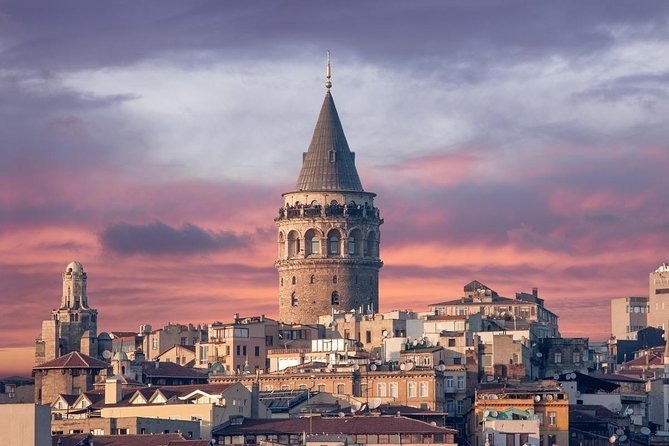Galata Tower: A Timeless Sentinel Over Istanbul
The Galata Tower, with its conical cap piercing the skyline of Istanbul, stands as a monumental witness to the city’s rich and tumultuous history. This iconic stone tower, located in the Galata district to the north of the Golden Horn, has been a significant landmark since its construction in the medieval era. Offering panoramic views of Istanbul, the tower is not only an architectural marvel but also a testament to the city’s diverse cultural heritage.
Historical Background
The Galata Tower, originally known as the Tower of Christ (Christea Turris in Latin), was constructed by the Genoese in 1348 during their expansion of the Galata district, which was then a Genoese colony. The tower replaced an older Byzantine tower called the Megalos Pyrgos, which controlled the northern end of the massive sea chain that spanned the Golden Horn.
The Genoese used the tower primarily for defense purposes. It played a crucial role in their fortifications, standing as the tallest structure in Istanbul at that time. Over the centuries, the tower’s purpose evolved, serving variously as a watchtower, a fire tower, and even a prison.
The Ottomans, who conquered Constantinople in 1453, also utilized the tower. Notably, in the 16th century, the tower was used by Ottoman scientist Hezarfen Ahmed Çelebi for his legendary flight. According to Ottoman historian Evliya Çelebi, Hezarfen Ahmed Çelebi used artificial wings to glide from the Galata Tower across the Bosphorus to Üsküdar, making it one of the earliest accounts of human flight.
Architectural Features
The Galata Tower stands approximately 67 meters tall and has a diameter of 16.5 meters at the base. Constructed primarily of stone, it has undergone several restorations over the centuries, with the most recent significant restoration occurring in the 1960s.
Exterior
The exterior of the tower is characterized by its cylindrical shape and conical roof. The tower’s stone walls, punctuated by small windows, create a robust and imposing appearance. The upper section of the tower, with its large windows, was added during the Ottoman period and provides the observation deck for visitors.
Interior
The tower’s interior is accessible by a modern elevator that takes visitors up to the seventh floor, from where they can climb a few more flights of stairs to reach the observation deck. Inside, the tower features exhibits on its history and the history of Istanbul, providing context and enriching the visitor experience.
Panoramic Views
One of the main attractions of the Galata Tower is its observation deck, which offers 360-degree views of Istanbul. From this vantage point, visitors can see the bustling cityscape, including landmarks such as the Hagia Sophia, the Blue Mosque, the Topkapi Palace, and the Bosphorus Strait.
These panoramic views have made the tower a popular spot for tourists and photographers, especially at sunrise and sunset when the city is bathed in golden light. The deck provides a unique perspective on the city’s sprawling layout, bridging Europe and Asia.
Cultural Significance
The Galata Tower is more than just an architectural landmark; it is a symbol of Istanbul’s historical layers and cultural diversity. Over the centuries, the tower has been a silent witness to the city’s transformations, from the Byzantine and Genoese eras to the Ottoman period and the modern Turkish Republic.
Legends and Myths
The tower is also shrouded in legends. The most famous is the story of Hezarfen Ahmed Çelebi’s flight, which symbolizes human ambition and ingenuity. Another legend holds that if two lovers visit the Galata Tower together for the first time, they will eventually marry, adding a romantic allure to the site.
Literary and Artistic References
The Galata Tower has inspired countless artists, writers, and poets. It appears in various literary works, paintings, and films, often symbolizing the enigmatic and multifaceted nature of Istanbul. Its timeless presence continues to captivate and inspire, making it an enduring symbol of the city.
Visitor Experience
Visiting the Galata Tower is a must-do for anyone exploring Istanbul. The combination of historical intrigue and breathtaking views makes it a memorable experience.
Practical Information
- Opening Hours: The tower is generally open daily from 9 AM to 8 PM, though hours can vary seasonally. It is advisable to check current opening times before visiting.
- Tickets: Tickets can be purchased at the entrance. There is usually a line, so it’s recommended to visit early in the morning or later in the afternoon to avoid peak times.
- Accessibility: The tower has an elevator that takes visitors most of the way up, but the final ascent to the observation deck requires climbing a few flights of stairs, which may not be suitable for those with mobility issues.
Nearby Attractions
The Galata district itself is a vibrant area worth exploring. Visitors can wander through its narrow, winding streets, filled with cafes, shops, and art galleries. Nearby attractions include the Galata Bridge, which connects the district to the historic peninsula of Istanbul, and the bustling Karaköy area with its modern eateries and nightlife.
Conclusion
The Galata Tower stands as a sentinel over Istanbul, offering a window into the city’s storied past and its dynamic present. With its rich history, architectural beauty, and panoramic views, it is a symbol of the cultural and historical depth that defines Istanbul. Whether you are a history buff, an architecture enthusiast, or simply a traveler seeking stunning vistas, a visit to the Galata Tower promises an unforgettable experience in one of the world’s most enchanting cities.





